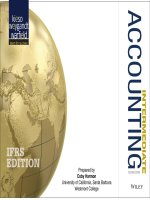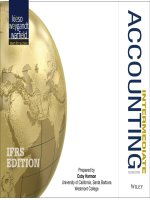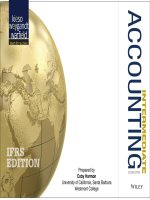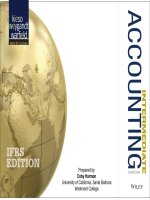Lecture Intermediate accounting (IFRS 2nd edition): Chapter 20 - Kieso, Weygandt, Warfield
Bạn đang xem bản rút gọn của tài liệu. Xem và tải ngay bản đầy đủ của tài liệu tại đây (1.78 MB, 56 trang )
20-1
PREVIEW OF CHAPTER
20
Intermediate Accounting
IFRS 2nd Edition
Kieso, Weygandt, and Warfield
20-2
20
Accounting for Pensions
and Postretirement Benefits
LEARNING OBJECTIVES
After studying this chapter, you should be able to:
1. Distinguish between accounting for
the employer’s pension plan and
accounting for the pension fund.
2. Identify types of pension plans and their
characteristics.
3. Explain measures for valuing the
pension obligation.
4. Identify amounts reported in financial
statements.
20-3
5. Use a worksheet for employer’s pension
plan entries.
6. Explain the accounting for past service
costs.
7. Explain the accounting for
remeasurements.
8. Describe the requirements for reporting
pension plans in financial statements.
9. Explain the accounting for other
postretirement benefits.
NATURE OF PENSION PLANS
An arrangement whereby an employer provides payments to retired
employees after for services they performed in their working years.
Pension Plan
Administrator
Employer
Retired
Employees
20-4
Assets &
Liabilities
LO 1
NATURE OF PENSION PLANS
Pension plans can be:
uContributory: employees voluntarily make payments to
increase their benefits.
uNoncontributory: employer bears the entire cost.
uQualified pension plans: offer tax benefits.
Pension fund should be a separate legal and accounting
entity.
20-5
LO 1
20
Accounting for Pensions
and Postretirement Benefits
LEARNING OBJECTIVES
After studying this chapter, you should be able to:
1. Distinguish between accounting for the
employer’s pension plan and
accounting for the pension fund.
2. Identify types of pension plans and
their characteristics.
3. Explain measures for valuing the
pension obligation.
4. Identify amounts reported in financial
statements.
20-6
5. Use a worksheet for employer’s pension
plan entries.
6. Explain the accounting for past service
costs.
7. Explain the accounting for
remeasurements.
8. Describe the requirements for reporting
pension plans in financial statements.
9. Explain the accounting for other
postretirement benefits.
NATURE OF PENSION PLANS
Defined Contribution Plan
u
Employer contribution
determined by plan (fixed)
u
Risk borne by employees
u
Benefits based on plan value
Defined Benefit Plan
u
Benefit determined by plan
u
Employer contribution varies
(determined by Actuaries)
u
Risk borne by employer
Companies engage actuaries to ensure that a pension plan is
appropriate for the employee group covered.
20-7
LO 2
NATURE OF PENSION PLANS
The Role of Actuaries in Pension Accounting
Actuaries make predictions of mortality rates, employee turnover,
interest and earnings rates, early retirement frequency, future
salaries, and other factors necessary to operate a pension plan.
They also compute the various pension measures that affect the
financial statements, such as
20-8
u
the pension obligation,
u
the annual cost of servicing the plan, and
u
the cost of amendments to the plan.
LO 2
20
Accounting for Pensions
and Postretirement Benefits
LEARNING OBJECTIVES
After studying this chapter, you should be able to:
1. Distinguish between accounting for the
employer’s pension plan and
accounting for the pension fund.
2. Identify types of pension plans and their
characteristics.
3. Explain measures for valuing the
pension obligation.
4. Identify amounts reported in financial
statements.
20-9
5. Use a worksheet for employer’s pension
plan entries.
6. Explain the accounting for past service
costs.
7. Explain the accounting for
remeasurements.
8. Describe the requirements for reporting
pension plans in financial statements.
9. Explain the accounting for other
postretirement benefits.
ACCOUNTING FOR PENSIONS
Two questions:
1.
2.
20-10
What is the pension obligation that a company should
report in the financial statements?
What is the pension expense for the period?
LO 3
ACCOUNTING FOR PENSIONS
Employer’s pension
obligation is the deferred
compensation obligation it
has to its employees for
their service under the
terms of the pension plan.
ILLUSTRATION 203
Different Measures of
the Pension Obligation
20-11
Measures of the Pension Liability
IASB’s
choice
LO 3
20
Accounting for Pensions
and Postretirement Benefits
LEARNING OBJECTIVES
After studying this chapter, you should be able to:
1. Distinguish between accounting for the
employer’s pension plan and
accounting for the pension fund.
2. Identify types of pension plans and their
characteristics.
3. Explain measures for valuing the
pension obligation.
4. Identify amounts reported in
financial statements.
20-12
5. Use a worksheet for employer’s pension
plan entries.
6. Explain the accounting for past service
costs.
7. Explain the accounting for
remeasurements.
8. Describe the requirements for reporting
pension plans in financial statements.
9. Explain the accounting for other
postretirement benefits.
ACCOUNTING FOR PENSIONS
Net Defined Benefit Obligation (Asset)
Net defined benefit liability (asset)
uReferred to as the funded status.
uRepresents the deficit or surplus related to a defined
pension plan.
ILLUSTRATION 204
Presentation of Funded Status
20-13
LO 4
ACCOUNTING FOR PENSIONS
Reporting Changes in the Defined Benefit
Obligation (Asset)
The IASB requires:
uAll changes in the defined benefit obligation and plan assets
in the current period be recognized in comprehensive
income.
uCompanies report changes arising from different elements of
pension liabilities and assets in different sections of the
statement of comprehensive income, depending on
their nature.
20-14
LO 4
Reporting Changes in Obligation (Asset)
ILLUSTRATION 205
Reporting Changes in the Pension Obligation (Assets)
20-15
Three Components
of Pension Costs
LO 4
Reporting Changes in Obligation (Asset)
1.
Service Cost
Component of
Pension Expense
u Current service cost increase in the present value of the
defined benefit obligation from employee service in the
current period.
u Past service cost change in the present value of the defined
benefit obligation for employee service for prior periods—
generally resulting from a plan amendment.
u Reported in the statement of comprehensive income in the
operating section of the statement and affects net income.
u Determine pension expense based on future salary levels.
u Assign benefits to period of service.
20-16
LO 4
Reporting Changes in Obligation (Asset)
2.
Net Interest
Component of
Pension Expense
u Computed by multiplying the discount rate by the funded
status of the plan (defined benefit obligation minus plan
assets).
u Net defined benefit obligation results in interest expense.
u Net defined benefit asset results in interest revenue.
u Amount is often shown below the operating section of the
income statement in the financing section.
u Discount rate is based on the yields of highquality bonds with
terms consistent with the company’s pension obligation.
20-17
LO 4
Reporting Changes in Obligation (Asset)
3.
Remeasurements
u Gains and losses related to the defined benefit obligation.
u Gains or losses on the fair value of the plan assets.
u This component is reported in other comprehensive income,
net of tax.
u Remeasurement gains or losses therefore affect comprehensive
income but not net income.
20-18
LO 4
ACCOUNTING FOR PENSIONS
Plan Assets and Actual Return
Plan Assets
uInvestments in shares, bonds, other securities, and real
estate.
uReported at fair value.
uEmployer contributions and the actual return on plan
assets increase pension plan assets.
uBenefits paid to retired employees decrease plan
assets.
20-19
LO 4
Plan Assets and Actual Return
Illustration: Hasbro Company has pension plan assets of
€4,200,000 on January 1, 2015. During 2015, Hasbro contributed
€300,000 to the plan and paid out retirement benefits of €250,000. Its
actual return on plan assets was €210,000 for the year. Compute the
amount of plan assets at December 31, 2015.
ILLUSTRATION 206
Determination of Pension Assets
20-20
LO 4
Plan Assets and Actual Return
Illustration: Hasbro Company has pension plan assets of
€4,200,000 on January 1, 2015. During 2015, Hasbro contributed
€300,000 to the plan and paid out retirement benefits of €250,000. Its
actual return on plan assets was €210,000 for the year. Some
companies compute the actual return as follows.
ILLUSTRATION 208
Computation of Actual Return on Plan Assets
20-21
LO 4
20
Accounting for Pensions
and Postretirement Benefits
LEARNING OBJECTIVES
After studying this chapter, you should be able to:
1. Distinguish between accounting for the
employer’s pension plan and
accounting for the pension fund.
2. Identify types of pension plans and their
characteristics.
3. Explain measures for valuing the
pension obligation.
4. Identify amounts reported in financial
statements.
20-22
5. Use a worksheet for employer’s
pension plan entries.
6. Explain the accounting for past service
costs.
7. Explain the accounting for
remeasurements.
8. Describe the requirements for reporting
pension plans in financial statements.
9. Explain the accounting for other
postretirement benefits.
USING A PENSION WORKSHEET
Pension Work Sheet
GENERAL JOURNAL ENTRIES
Items
Annual
Pension
Expense
Cash
OCIGain/Loss
The “General Journal Entries” columns
determine the journal entries to record in
the formal general ledger accounts.
20-23
MEMO RECORD
Pension
Asset /
Liability
Defined
Benefit
Obligation
Plan
Assets
The “Memo Record”
columns maintain balances
for the defined benefit
obligation and plan assets.
LO 5
2015 Entries and Worksheet
Illustration: On January 1, 2015, Zarle Company provides the
following information related to its pension plan for the year 2015.
l
Plan assets, January 1, 2015, are €100,000.
l
Defined benefit obligation, January 1, 2015, is €100,000.
l
Annual service cost is €9,000.
l
Discount rate is 10 percent.
l
Funding contributions are €8,000.
l
Benefits paid to retirees during the year are €7,000.
Instructions: Prepare a pension worksheet and pension journal
entry for Zarle Company for the year ending December 31, 2015.
20-24
LO 5
2015 Entries and Worksheet
2015 Pension worksheet for Zarle Company.
GENERAL JOURNAL ENTRIES
Items
Jan. 1, 2015
Annual
Pension
Expense
Service costs
Cash
OCIGain/Loss
Pension
Asset /
Liability
0
MEMO RECORD
Defined
Benefit
Plan
Obligation
Assets
(100,000)
100,000
9,000
(9,000)
Interest expense
10,000
(10,000)
Interest revenue
(10,000)
Contributions
10,000
(8,000)
8,000
Benefits
Journal entry
7,000
9,000
Dec. 31, 2015
Obligation $100,000 x 10%
(8,000)
(7,000)
(1,000)
-
(1,000)
(112,000)
111,000
($1,000) net liability
Assets $100,000 x 10%
20-25
LO 5









